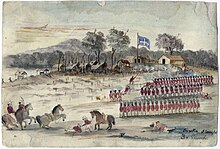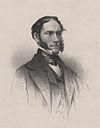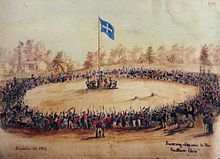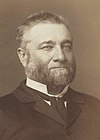
The Eureka Rebellion was a series of events involving gold miners who revolted against the British colonial government in Victoria, Australia during the Victorian gold rush. It culminated in the Battle of the Eureka Stockade, which took place on 3 December 1854 at Ballarat between the rebels and the colonial forces of Australia. The fighting left at least 27 dead and many injured, most of the casualties being rebels. There was a preceding period beginning in 1851 of peaceful demonstrations and civil disobedience on the Victorian goldfields. The miners, many of whom such as Raffaello Carboni came from Europe and were veterans of the Revolutions of 1848, had various grievances, chiefly the cost of mining permits and the officious way the system was enforced.

The Eureka Flag was flown at the Battle of the Eureka Stockade, which took place on 3 December 1854 at Ballarat in Victoria, Australia. It was the culmination of the 1851–1854 Eureka Rebellion on the Victorian goldfields. Gold miners protested the cost of mining permits, the officious way the colonial authorities enforced the system, and other grievances. An estimated crowd of over 10,000 demonstrators swore allegiance to the flag as a symbol of defiance at Bakery Hill on 29 November 1854. It was then flown over the Eureka Stockade during the battle that resulted in at least 27 deaths. Around 120 miners were arrested, and many others were badly wounded, including 5 soldiers.

John King (1830-1881) was a police constable at the Battle of the Eureka Stockade who was responsible for seizing the rebel war flag.

The Battle of the Eureka Stockade was fought in Ballarat, Victoria, Australia on 3 December 1854, between gold miners and the colonial forces of Australia. It was the culmination of the 1851–1854 Eureka Rebellion during the Victorian gold rush. The fighting resulted in at least 27 deaths and many injuries, the majority of casualties being rebels. The miners had various grievances, chiefly the cost of mining permits and the officious way the system was enforced.

Since 2012, various theories have emerged, based on the Argus account of the Battle of the Eureka Stockade and an affidavit sworn by Private Hugh King three days later as to a flag being seized from a prisoner detained at the stockade, concerning whether a Union Jack, known as the Eureka Jack was also flown by the rebel garrison. Readers of the Argus were told that:
The flag of the diggers, "The Southern Cross," as well as the "Union Jack," which they had to hoist underneath, were captured by the foot police.

The Eureka Rebellion, an 1854 gold miner's revolt in Victoria, Australia, has been the inspiration for numerous novels, poems, films, songs, plays and artworks. Much of Eureka folklore relies heavily on Raffaello Carboni's 1855 book, The Eureka Stockade, which is the first and only comprehensive eyewitness account of the uprising. The poet Henry Lawson wrote about Eureka, as have many novelists.

The following is a comprehensive timeline of the Eureka Rebellion.

The 1855 Victorian high treason trials took place between 22 February – 27 March in the aftermath of the Battle of the Eureka Stockade. The Goldfields Commission recommended a general amnesty for all on the runs from the fallen Eureka Stockade. Instead, thirteen of the rebels detained were eventually indicted for high treason. The juries all returned a verdict of not guilty by a jury, and the indictment against Thomas Dignum was withdrawn. On 23 January, the trial of Ballarat Times editor Henry Seekamp resulted in a finding of guilt for seditious libel, and a month later, he was sentenced to a term of imprisonment of six months. The trials have been described as farcical, and the colonial secretary would rebuke Governor Sir Charles Hotham over prosecuting the Eureka rebels for the lofty offence of high treason.

There were key people involved in the Eureka Rebellion who subscribed to the ideals of Chartism and saw the struggle on the Victorian goldfields as a continuation of the activism in Britain in the 1840s and "the centuries of heroic struggles in England which preceded the Australian Federation" such as the 1688 Glorious Revolution, that resulted in the enactment of the English Bill of Rights. From 1837 to 1848, 129,607 incomers to Australia arrived from the British mainland, with at least 80 "physical force" chartists sentenced to penal servitude in Van Diemens Land. Currey agrees that the population at the time would have been sufficiently politically awake such that: "it may be fairly assumed that the aims of the Anti-Corn-Law League and the Chartists were very familiar to many of the Victorian miners".

The Eureka Stockade was a crude battlement built in 1854 by rebel gold miners at Ballarat, Australia during the Eureka Rebellion. It stood from 30 November until the Battle of the Eureka Stockade on 3 December. The exact dimensions and location of the stockade are a matter of debate among scholars. There are various contemporary representations of the Eureka Stockade, including the 1855 Victorian high treason trials map and Eureka Slaughter by Charles Doudiet.
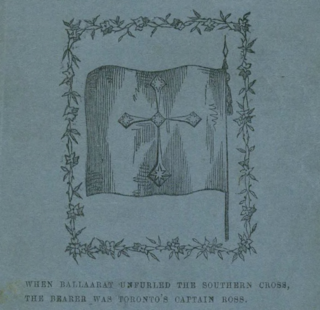
The Eureka Stockade is an 1855 novel by Raffaello Carboni, who was present in Ballarat during the Eureka Rebellion. He lived near the Eureka Stockade and witnessed the battle on 3 December 1854 when the government forces defeated the rebel garrison. The Eureka folklore is deeply indebted to Carboni's novel, the first and only comprehensive eyewitness account of the Eureka Rebellion.

The Victorian gold rush led to an influx of foreign nationals, increasing the colony's population from 77,000 in 1851 to 198,496 in 1853. Many such as Raffaello Carboni had experienced the Revolutions of 1848. They supported the protest movement that formed on the goldfields in opposition to the mining tax system, ultimately leading to an armed uprising at Ballarat. It is currently known that the participants in the Battle of the Eureka Stockade on 3 December 1854 came from at least 23 different nations, including Australia, Canada, the United States of America, Jamaica, Mauritius, Russia, Norway, Finland, Sweden, Denmark, Poland, Switzerland, Italy, Greece, The Netherlands, Scotland, Ireland, England, Wales, Germany, France, Portugal and Spain. Carboni recalled that "We were of all nations and colours." During the 1855 Victorian high treason trials, the Argus court reporter observed that of "the first batch of prisoners brought up for examination, the four examined consisted of one Englishman, one Dane, one Italian, and one negro, and if that is not a foreign collection, we do not know what is." However, despite being present on the Ballarat gold fields, there is no record of any Chinese involvement at the Eureka Stockade. According to figures published by Professor Anne Beggs-Sunter, in her sample of 44 rebels, only one hailed from a non-European country.

During the Battle of the Eureka Stockade, there was a dog that remained at the side of one of the pikemen and even followed his dead body to the cemetery. Christopher Crook, who was a correspondent for the Geelong Advertiser, is quoted in Wiliam Wither's A History of Ballarat as saying:
A little terrier sat on the breast of the man I spoke of, and kept a continuous howl; it was removed, but always returned to the same spot, and when the miner's body was huddled, with the other corpses, into the cart, the little dog jumped in after him, and lying on his dead master's breast, began howling again.

The vexillological aspects of the Eureka Rebellion include the Eureka Flag and others used in protest on the goldfields and those of the British Army units at the Battle of the Eureka Stockade. The disputed first report of the attack on the Eureka Stockade also refers to a Union Jack, known as the Eureka Jack, being flown during the battle that was captured, along with the Eureka Flag, by the foot police.

The Victorian colonial police force of the 1850s operated as an armed paramilitary gendarmerie where troopers and police were garrisoned at central locations, such as the government camp in Ballarat, and there was no interaction with the civilian population. To cope with the expansion of the mining industry, the Victorian government resorted to recruiting at least 130 former convicts from Tasmania who were prone to brutal means. They would get a fifty per cent commission from all fines imposed on unlicensed miners and sly grog sellers. Plainclothes officers enforced prohibition, and those involved in the illegal sale of alcohol were initially handed 50-pound fines. There was no profit for police from subsequent offences, that were instead punishable by months of hard labour. This led to the corrupt practice of police demanding blackmail of 5 pounds from repeat offenders. By January 1853, there were 230 mounted police throughout Victoria. By 1855, the number had risen to 485, including nine mounted detectives.


